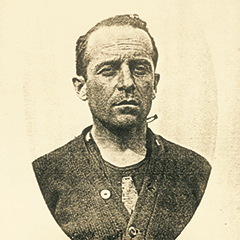John J. F. Mulcahy Sr.
 John J. F. “Jack” Mulcahy Sr.
John J. F. “Jack” Mulcahy Sr.
St. John’s College, Class of 1894
Gold and Silver Medalist, Rowing, 1904 Summer Olympics
Founder of Fordham Rowing
A pioneer in the sport of rowing, Jack Mulcahy earned his first title in double sculls in 1891—the same year he graduated from the second division of St. John’s College, known today as Fordham Prep. He stayed at Fordham, graduating from the first division in three years, and rose to national prominence at the 1904 Summer Olympics in St. Louis, where he and his partner, William Varley, earned two medals: the gold in double sculls and the silver in coxless pairs. A decade later, he returned to his alma mater, where he is best remembered as the founder of Fordham rowing.
John Joseph Francis Mulcahy was born in New York City on July 20, 1876, one of four children of Mortimer and Hannah-Cecilia Mulcahy. He developed an interest in rowing at an early age, in an era when regattas attracted thousands of spectators to the banks of the Harlem River. The Spanish-American War interrupted his sporting ambitions. He enlisted in the Navy in late April 1898 and, for the next four months, served as a seaman on the U.S.S. Nahant. After the war, he worked as the local representative of Worth Brothers, a Pittsburgh-based steel company.
While St. Louis was the site of Mulcahy’s greatest athletic triumph, it also marked the start of his storybook romance with Katherine Vilsack, a young heiress and philanthropist from Pittsburgh. With his chiseled physique, Mulcahy had served as the model for the “Strength” and “Power” figures created by sculptor Melva Beatrice Wilson for the spandrels of the Mechanical Building at the St. Louis World’s Fair, which coincided with the Olympic games. Vilsack met Mulcahy after the sculptures caught her eye, and the two were married at St. Paul Cathedral in Pittsburgh on January 7, 1909, making news throughout the country. One article compared their romance to the myth of Pygmalion and Galatea, while The Dallas Morning News featured the titillating headline “Loves Statue: Married to Man.”
Following his success at the Olympics, Mulcahy served briefly on the New York City Board of Aldermen and became a vice president of Midvale Steel Company. He also devoted increasing amounts of his time and talent to supporting athletics at Fordham. In early 1915, he helped the University launch its rowing program and served as the team’s inaugural coach. Vincent M. Doherty, a 1918 graduate and a member of the 1915 freshman crew, recalled his former coach as a dapper, intense man. “Although Jack was a stern master,” Doherty wrote in 1980, “he had the affection and respect of every man on the squad.”
Fordham’s first Olympic champion died on November 19, 1942, survived by his wife and four children. He was inducted into the National Rowing Hall of Fame in 1956 and into the Fordham Athletics Hall of Fame in 1991. He is revered among Fordham rowers, both past and present, who share his passion for the sport’s relentless focus on teamwork.